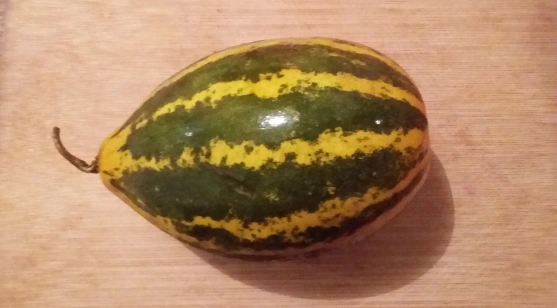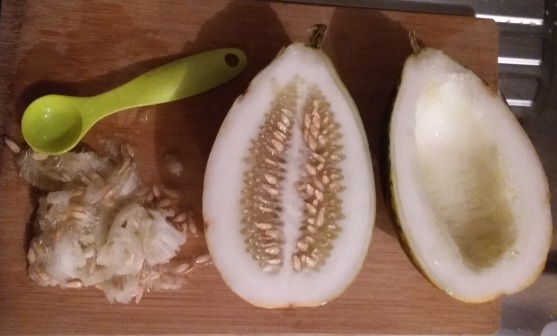
Name: Vellery
Appearance: You may be wondering, dear readers, how I select the fruit and vegetables for scrutiny within this blog. It turns out there are only a few loose criteria. The specimen must be a fruit or vegetable that is sufficiently strange in appearance to be potentially confused with a soft tissue growth or alien egg. It does not necessarily need to possess an unusual name, but this is definitely an advantage. It also helps if I’ve never seen it before – and, given that I grew up in the UK, that northern stronghold of fussy eaters, this applies to a startling percentage of fresh produce available within the UAE.
The vellery fulfils all of these criteria, and had been on my radar for a while; it was certainly something I’d never seen in a British supermarket. In my supposedly expert opinion, the vellery’s smooth, streaky green-and-yellow skin marked it out as a relative of the squash – perfect, I speculated, for squishing into veggie patty form.
Only, the vellery isn’t a squash, as I discovered when I opened it up. It’s a melon. I don’t think there is a greater first world problem than preparing yourself for making delicious (if questionable) veggie burgers, and then discovering that the weird vegetable you have selected for this task is sister to the blandest of fruits. I wonder if I will ever quite recover from the shock.
Where do they eat it? Most specimens you’ll find in the UAE have been imported from India, and indeed, once I’ve done a little more research into the origins of this melon relative, I discover that it’s eaten in Kerala. There seems to be precious little information about the provenance and consumption of this on the internet, though, so if you know anything else please do let me know in the comments.

Preparation: Prepare your vellery as you would a melon: slice it open, scoop out the seeds and pulp with a teaspoon, and cut the remaining flesh and skin into ergonomic slices.
So, what does it taste like? The white flesh of the vellery smells fresh and sweet, and during my initial tasting I can detect no discernable difference between it and a honeydew melon. After a few more bites, I notice that the vellery has a marginally more crunchy texture than your classic honeydew, and is definitely not as sweet as its more well-known counterpart. Indeed, its juice imparts an almost lemony, acidic aftertaste. I can envisage the vellery working well in a salad, perhaps as an alternative to cucumber or celery.
Verdict: 3/5
I’m not a big fan of melon, but there isn’t anything particularly offensive about this weird-looking customer, and it went down well with my other, considerably more open-minded tester. I would buy it again if I got a craving for something non-to-sweet and juicy, or if it was a particularly hot day in the sandpit.
